Nucor Bundle
How Does Nucor Company Thrive in the Steel Industry?
Nucor Corporation isn't just another steel producer; it's a powerhouse reshaping the industry. As North America's largest recycler and a leader in Nucor SWOT Analysis, Nucor steel production impacts markets and economies. Its strategic moves, like setting a hot-rolled coil base price, demonstrate its ability to navigate complex trade policies and market fluctuations.
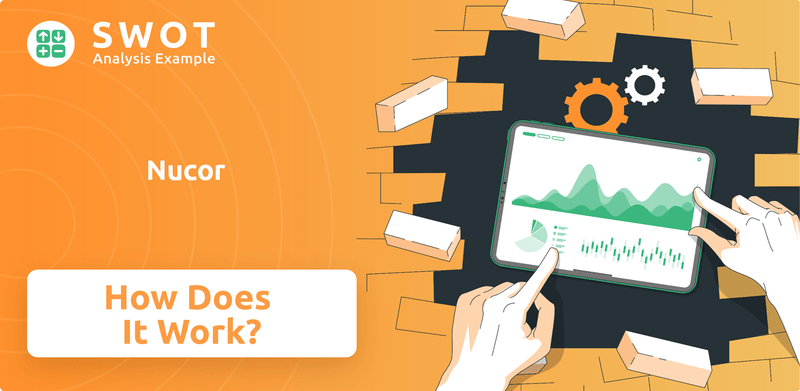
Delving into How Nucor works is crucial for understanding the dynamics of steel manufacturing and the broader economic landscape. With a strong financial footing, including billions in cash and a substantial credit facility, Nucor's business model is built for resilience. This analysis will explore Nucor's competitive advantages, including its innovative steel production process, and its impact on the US economy.
What Are the Key Operations Driving Nucor’s Success?
The Nucor Company, a leading player in the steel industry, operates through a vertically integrated and diversified business model. Its core focus is on manufacturing and selling steel and steel products. This includes a broad range of items like carbon and alloy steel in various forms, along with fabricated steel products designed for construction, energy, advanced manufacturing, and automotive sectors.
Nucor's value proposition revolves around delivering high-quality, cost-effective, and sustainably produced steel products. This is achieved through a combination of efficient operations, a robust supply chain, and a decentralized management structure. The company's commitment to sustainability, particularly its leadership in recycling and electric arc furnace (EAF) steelmaking, further differentiates its offerings in the market.
How Nucor works is largely defined by its operational efficiency and strategic approach to steel production. The company's use of EAFs, which utilize recycled steel scrap, positions it as a major recycler in North America. This not only supports a more environmentally friendly process but also helps control raw material costs. Additionally, Nucor maintains a well-integrated supply chain and distribution network to ensure consistent product delivery and customer satisfaction.
Nucor's steel production process is primarily based on electric arc furnaces (EAFs), which melt recycled steel scrap. This method is more sustainable than traditional blast furnaces. The company's steel mill operating rates were at 80% in the first quarter of 2025, reflecting its operational efficiency.
Nucor has a robust supply chain, including The David J. Joseph Company for scrap brokering and processing. It also produces direct reduced iron (DRI) for its steel mills. Strategic partnerships and a well-established distribution network ensure efficient product delivery. The company's approach to Owners & Shareholders of Nucor highlights its strong financial and operational strategies.
Nucor employs a decentralized management structure to enhance agility and responsiveness to local market conditions. It also emphasizes continuous improvement initiatives like Six Sigma and Lean Manufacturing. These strategies contribute to its operational excellence and ability to adapt to changing market dynamics.
Nucor serves diverse customer segments, including construction, energy, advanced manufacturing, and automotive sectors. Its product portfolio includes carbon and alloy steel in bars, beams, sheet, and plate, along with fabricated steel products. This wide range supports various industry needs.
Nucor's operational efficiency and strategic approach to steel production provide several key advantages. The use of EAFs and recycled steel scrap supports a sustainable model, while the decentralized management structure fosters agility. These factors contribute to the company's competitive edge and ability to meet market demands.
- Efficient Electric Arc Furnace (EAF) technology.
- Vertical integration and control over raw materials.
- Decentralized management for market responsiveness.
- Commitment to continuous improvement.
Nucor SWOT Analysis
- Complete SWOT Breakdown
- Fully Customizable
- Editable in Excel & Word
- Professional Formatting
- Investor-Ready Format
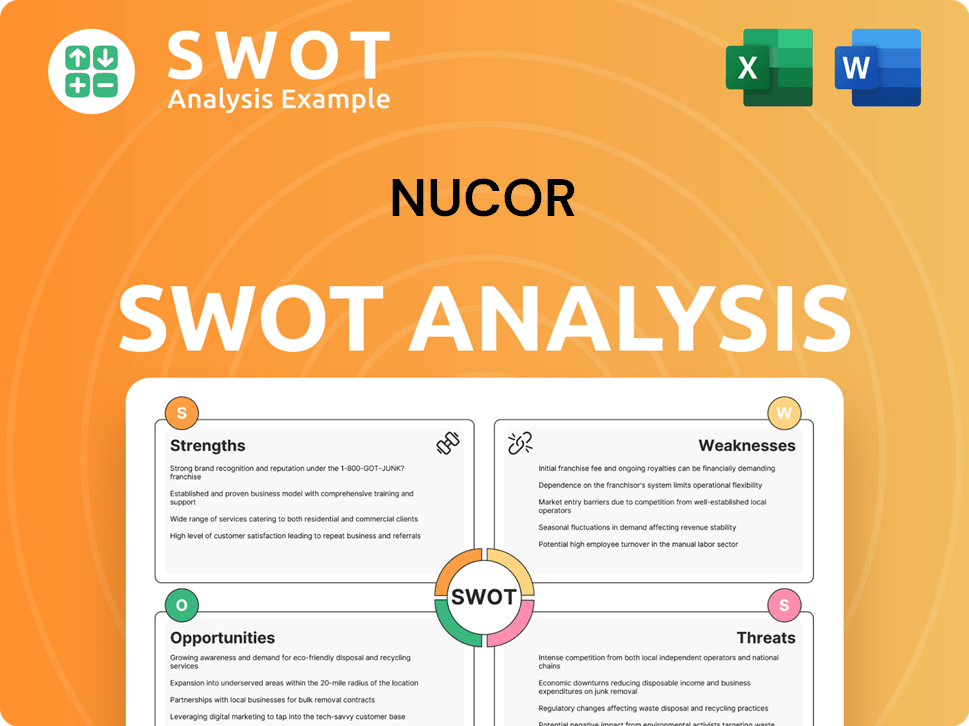
How Does Nucor Make Money?
The Nucor Company generates revenue primarily through the sale of its diverse range of steel and steel products, with operations spanning steel mills, steel products, and raw materials. Understanding its revenue streams and monetization strategies is key to grasping how Nucor operates within the steel manufacturing industry. The company's financial performance reflects its ability to navigate market dynamics and adapt its pricing strategies.
For the full year 2024, Nucor reported consolidated net sales of $30.73 billion. In the first quarter of 2025, net sales were $7.83 billion, an 11% sequential increase from Q4 2024, though a 4% year-over-year decrease. This demonstrates the fluctuating nature of the steel market and Nucor's responsiveness to these changes.
The Nucor business model is built on three core segments: Steel Mills, Steel Products, and Raw Materials. Each segment contributes differently to the overall financial health of the company, influenced by market conditions, pricing strategies, and operational efficiencies. Strategic pricing and expansion initiatives are key to Nucor's future revenue growth.
This segment produces carbon and alloy steel. In Q1 2025, despite lower selling prices, operational improvements led to increased volumes and a 43% increase in adjusted pre-tax earnings compared to the previous quarter. This segment is a significant contributor to Nucor steel production.
This segment processes raw steel into finished goods such as joists, deck, and metal building systems. Earnings in this segment declined by 44% year-over-year in Q1 2025 due to margin compression, as input costs outpaced selling prices. This highlights the challenges in managing costs within the steel production process.
This segment includes Nucor's scrap and direct reduced iron (DRI) facilities. It reported $29 million in Q1 2025, a more than threefold increase from the prior year, despite a sequential decline due to weaker margins. This segment supports Nucor's integrated operations.
Strategic pricing is a key monetization strategy. Nucor's Consumer Spot Price (CSP) for hot-rolled coil (HRC) is a key benchmark. For example, Nucor raised its HRC CSP to $890 per ton effective June 9, 2025, capitalizing on enhanced Section 232 tariffs. This dynamic pricing approach allows Nucor to adapt to fluctuating raw material costs, supply-demand balances, and international trade policies.
The company's pricing strategy in 2024-2025 has been marked by volatility, with nine consecutive price increases from late 2024 through March 2025, followed by periods of stabilization and slight reductions in April and May 2025. This reflects the Nucor's ability to respond to market changes.
Ongoing strategic initiatives include expanding product offerings and enhancing existing plant capabilities, which are expected to contribute to future revenue growth. This focus aligns with Nucor's long-term growth strategy.
Understanding How Nucor works involves recognizing its multifaceted revenue streams and dynamic pricing strategies. The company's ability to adapt to market fluctuations and optimize operations across its segments is crucial for its financial performance. For more insights, consider reading about the Target Market of Nucor to understand its customer base.
- Nucor generates revenue through steel mills, steel products, and raw materials.
- Strategic pricing and operational improvements are key revenue drivers.
- The company's financial performance is influenced by market dynamics and strategic initiatives.
- Nucor focuses on expanding product offerings and enhancing plant capabilities for future growth.
Nucor PESTLE Analysis
- Covers All 6 PESTLE Categories
- No Research Needed – Save Hours of Work
- Built by Experts, Trusted by Consultants
- Instant Download, Ready to Use
- 100% Editable, Fully Customizable
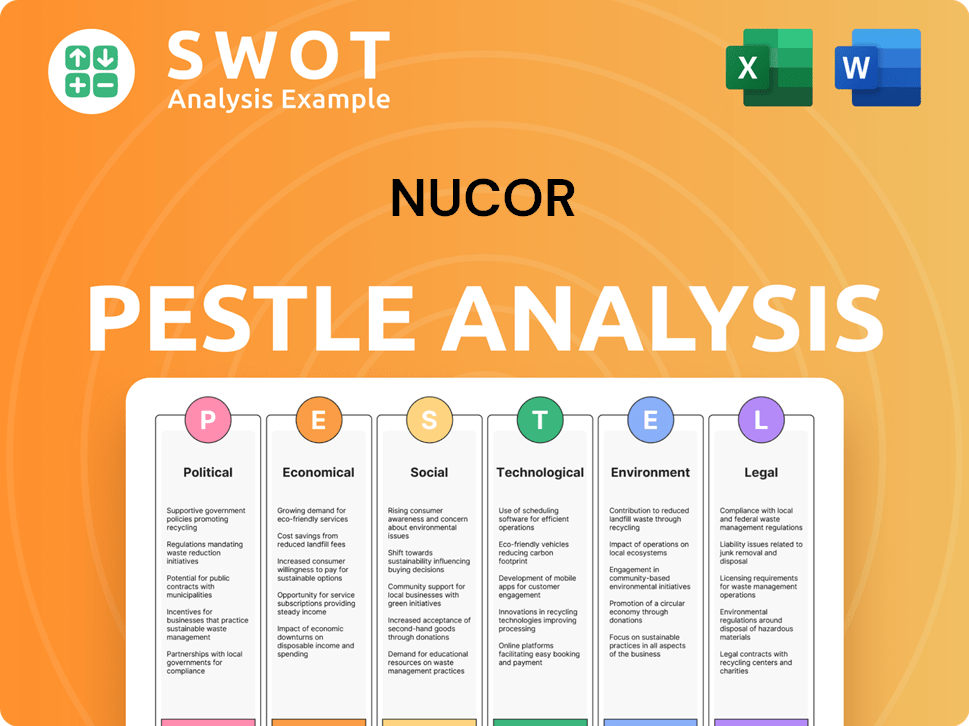
Which Strategic Decisions Have Shaped Nucor’s Business Model?
The evolution of the Nucor Company has been marked by significant milestones and strategic moves that have solidified its position in the steel industry. A key aspect of its strategy involves continuous investment in growth projects and capacity expansion. These initiatives include new facilities and the enhancement of existing plant capabilities, demonstrating a long-term commitment to growth within the steel manufacturing sector.
Nucor's strategic approach also includes diversifying its offerings beyond raw steel. Recent acquisitions, such as Rytec and Southwest Data Products (now Nucor Data Systems), highlight a shift towards providing comprehensive solutions, allowing the company to capitalize on rapidly growing markets. This strategic move enables Nucor to offer a more complete package to its customers, enhancing its market position and revenue streams.
Operational challenges, such as fluctuating steel prices and supply chain disruptions, have been consistently navigated by Nucor. The company's ability to maintain profitability through operational efficiency, even during periods of declining profitability, underscores its resilience. This adaptability, combined with strategic initiatives, positions Nucor favorably in the competitive landscape.
Nucor's history is marked by strategic expansions and technological advancements. The company's early adoption of electric arc furnace (EAF) steelmaking technology was a pivotal move, providing both cost-effectiveness and environmental benefits. This approach, combined with a decentralized management structure, has fostered operational excellence and adaptability.
Nucor's strategic moves include significant capital expenditures and acquisitions. The company has outlined a substantial capital expenditure plan of $3.0 billion for 2025, following $3.17 billion in 2024. Acquisitions like Rytec and Southwest Data Products demonstrate a diversification strategy. These moves are designed to expand product offerings and enhance plant capabilities.
Nucor's competitive advantages are multifaceted, including its leadership in EAF steelmaking, which utilizes recycled scrap. The company's decentralized management structure and focus on continuous improvement also contribute to its operational excellence. Furthermore, Nucor maintains strong financial health, providing flexibility for strategic investments and weathering economic cycles.
Nucor has demonstrated consistent financial strength, marked by robust liquidity and strong credit ratings. The company's consistent dividend payments, with its 208th consecutive quarterly payout in Q1 2025, highlight its commitment to shareholder returns. The doubling of U.S. steel tariffs to 50% in June 2025 is expected to positively impact the company.
Nucor's business model is built on efficiency, innovation, and strategic investments. The company focuses on EAF steelmaking, which allows for flexibility in raw material sourcing, primarily using recycled scrap. This approach reduces costs and minimizes environmental impact, contributing to Nucor's sustainability initiatives.
- Electric Arc Furnace (EAF) Steelmaking: Utilizes recycled scrap, providing cost-effectiveness and environmental benefits.
- Decentralized Management: Fosters operational excellence and adaptability.
- Strategic Investments: Focused on capacity expansion and product diversification.
- Financial Strength: Robust liquidity and consistent dividend payments.
Nucor Business Model Canvas
- Complete 9-Block Business Model Canvas
- Effortlessly Communicate Your Business Strategy
- Investor-Ready BMC Format
- 100% Editable and Customizable
- Clear and Structured Layout
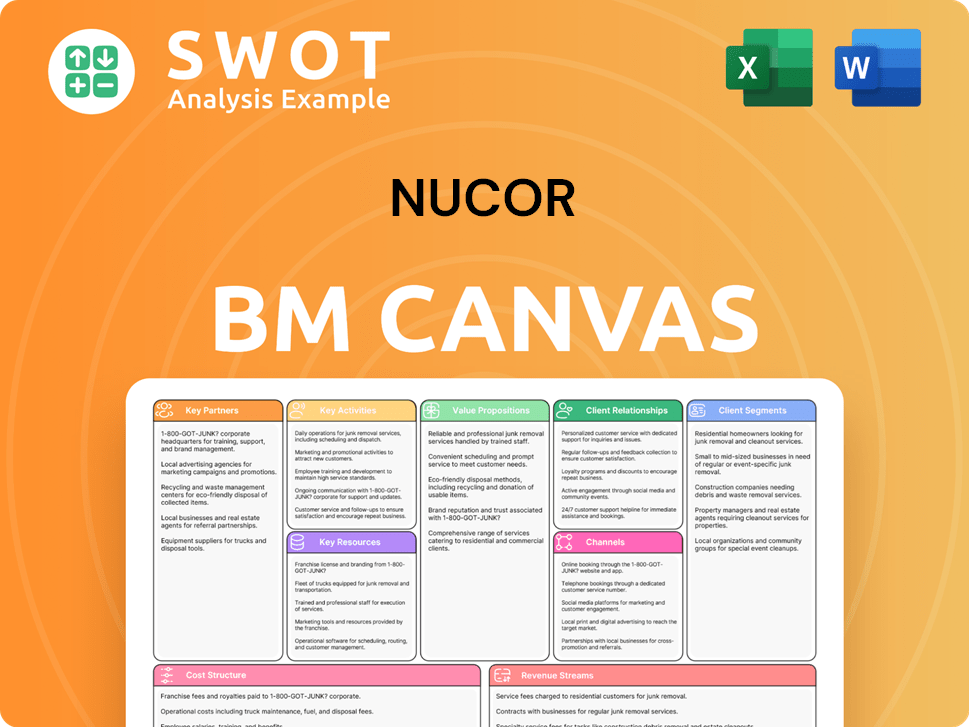
How Is Nucor Positioning Itself for Continued Success?
The Nucor Company holds a significant position in the steel industry, recognized as the largest steel producer in North America by market capitalization. Its market share, based on total revenue, was approximately 19.34% in the first quarter of 2025. The company faces competition from both domestic and foreign firms, primarily competing on price and service, but maintains customer loyalty through high-quality products and continuous improvement.
Nucor's operations are primarily based in the U.S. and Canada, with a presence in Mexico. Despite its strong market position, Nucor faces risks such as cyclicality in the steel industry, raw material costs, and trade policies. The company's financial performance is subject to fluctuations in steel prices, global demand, and regulatory changes, including tariffs. Cybersecurity threats also pose a risk, as demonstrated by a recent cyberattack that disrupted production.
Nucor is the largest steel producer in North America by market capitalization, with a market share of approximately 19.34% in Q1 2025. It competes on price and service against both domestic and foreign firms. The company's customer loyalty is supported by its high-quality products and continuous improvement initiatives.
The steel industry's cyclical nature, influenced by global demand and raw material costs, poses a risk. Fluctuating steel prices and regulatory changes, such as tariffs, also create uncertainty. Cybersecurity threats, as demonstrated by a May 2025 cyberattack, are another significant risk. Global steel overcapacity remains a persistent concern.
Nucor anticipates improved market conditions in 2025, driven by steel-intensive megatrends. The company plans significant capital expenditures, estimated at $3.0 billion for 2025. Analysts project Nucor's EPS to reach approximately $8.03 for 2025, with continued growth through 2029. Nucor's focus on sustainable practices positions it well for long-term growth.
Nucor's net income decreased to $2.03 billion in 2024 from $4.53 billion in 2023. The company projects higher earnings for Q2 2025, particularly in the steel mills segment. Analysts project EPS to reach approximately $8.03 for 2025, a substantial increase from $5.66 in 2024.
Nucor is investing heavily in capital expenditures, with an estimated $3.0 billion planned for 2025 to expand product offerings and enhance plant capabilities. Management projects higher earnings for Q2 2025, driven by anticipated increases in realized steel prices. The company's sustainability initiatives, including its EAF steelmaking process, also support long-term growth.
- Capital expenditures of $3.0 billion in 2025
- Anticipated higher earnings in Q2 2025
- Focus on sustainable practices and EAF steelmaking
- Expansion into new markets and product offerings
Nucor Porter's Five Forces Analysis
- Covers All 5 Competitive Forces in Detail
- Structured for Consultants, Students, and Founders
- 100% Editable in Microsoft Word & Excel
- Instant Digital Download – Use Immediately
- Compatible with Mac & PC – Fully Unlocked
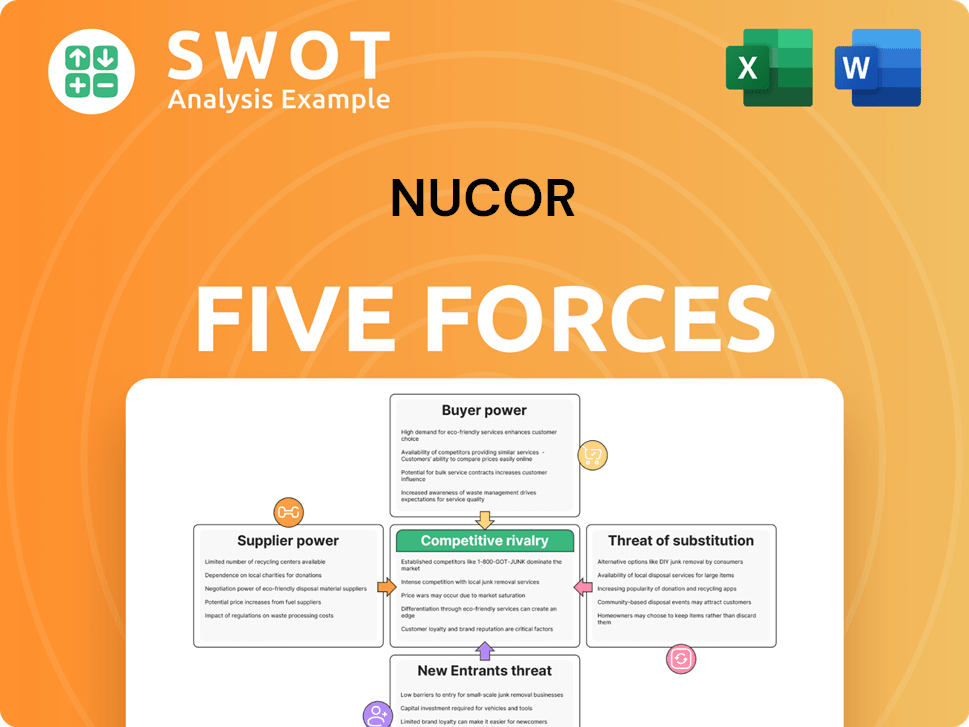
Related Blogs
- What are Mission Vision & Core Values of Nucor Company?
- What is Competitive Landscape of Nucor Company?
- What is Growth Strategy and Future Prospects of Nucor Company?
- What is Sales and Marketing Strategy of Nucor Company?
- What is Brief History of Nucor Company?
- Who Owns Nucor Company?
- What is Customer Demographics and Target Market of Nucor Company?
Disclaimer
All information, articles, and product details provided on this website are for general informational and educational purposes only. We do not claim any ownership over, nor do we intend to infringe upon, any trademarks, copyrights, logos, brand names, or other intellectual property mentioned or depicted on this site. Such intellectual property remains the property of its respective owners, and any references here are made solely for identification or informational purposes, without implying any affiliation, endorsement, or partnership.
We make no representations or warranties, express or implied, regarding the accuracy, completeness, or suitability of any content or products presented. Nothing on this website should be construed as legal, tax, investment, financial, medical, or other professional advice. In addition, no part of this site—including articles or product references—constitutes a solicitation, recommendation, endorsement, advertisement, or offer to buy or sell any securities, franchises, or other financial instruments, particularly in jurisdictions where such activity would be unlawful.
All content is of a general nature and may not address the specific circumstances of any individual or entity. It is not a substitute for professional advice or services. Any actions you take based on the information provided here are strictly at your own risk. You accept full responsibility for any decisions or outcomes arising from your use of this website and agree to release us from any liability in connection with your use of, or reliance upon, the content or products found herein.